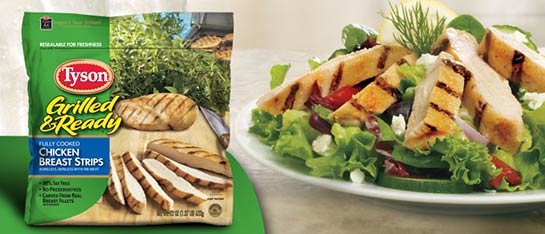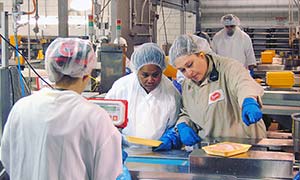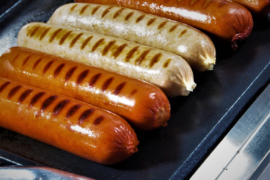Tyson Foods, Inc. on August 8 reported that third quarter operating income was up 36% to $767 million, as adjusted income rose 35% compared to the same period in 2015. The Springdale, Arkansas, USA-headquartered company’s chicken segment posted an operating margin of 13.9%, while the prepared foods and pork segments respectively recorded operating margins of 10.9% and 9.6%.
The performance translated to record earning per share of $1.25, up 51% over the same period in 2015.
“We again demonstrated our ability to deliver higher, more stable earnings through our differentiated business model that emphasizes growth in prepared foods and value-added chicken. We produced record third quarter earnings per share, operating income and return on sales. All operating segment results were in or above their normalized operating margin ranges,” said CEO Donnie Smith. “At retail, our products are growing in sales volume, sales dollars and category share according to IRI, and Tyson is a leader in volume sales growth among the top 10 branded food companies.”
Summary of Segment Results
- Chicken sales volume decreased in the third quarter and nine months of fiscal 2016 as a result of the company’s mix and buy versus grow strategy. Average sales prices increased slightly in the third quarter, while decreasing for the nine months of the fiscal year as feed ingredient costs declined, partially offset by mix changes. Operating income rose due to improved operational execution and lower feed ingredient costs. Feed costs decreased $50 million and $190 million during the third quarter and nine months of fiscal 2016, respectively.

- Beef sales volume increased in the third quarter due to an increase in live cattle processed as a result of higher fed cattle supplies. Sales volume also rose for the nine months of fiscal 2016 thanks to better demand for beef products despite a reduction in live cattle processing capacity due to closure of the Denison, Iowa, facility in the fourth quarter of fiscal 2015. Average sales prices declined in an environment with higher domestic availability of beef supplies, which drove down livestock costs. Operating income advanced due to more favorable market conditions associated with an increase in cattle supply, which resulted in lower fed cattle costs.
- Pork sales volume decreased in the third quarter of fiscal 2016, despite increased production, due to reduced inventory levels as well as mix changes related to internally sourcing more hogs from the company’s live operation. Sales volume decreased for the nine months of the fiscal year due to the divestiture of our Heinold Hog Markets business in the first quarter of fiscal 2015.
Excluding the impact of the divestiture, Tyson’s sales volume grew 1.5% driven by better demand for pork products. The average sales price increased in the third quarter as demand for pork products outpaced the slight increase in live hog supplies. For the nine months of fiscal 2016, live hog supplies increased, which drove down livestock costs and the average sales price. Operating income increased for the third quarter and nine months of fiscal 2016 due to better plant utilization associated with higher volumes.
- Prepared Foods sales volume increased in the third quarter as a result of improved demand. However, volume decreased for the nine months of fiscal 2016, despite increased sales in the third quarter, as a result of lower sales volume in the first six months of fiscal 2016 due to changes in sales mix as well as the carryover effect of the 2015 turkey avian influenza occurrence into the first half of fiscal 2016. Average sales prices decreased primarily due to a decline in input costs, partially offset by a change in product mix.
 Operating income in the prepared foods segment remained strong in the third quarter as a result of strong demand for products partially offset with higher promotional spending. Operating income increased due to mix changes as well as lower input costs of approximately $215 million for the nine months of fiscal 2016.
Operating income in the prepared foods segment remained strong in the third quarter as a result of strong demand for products partially offset with higher promotional spending. Operating income increased due to mix changes as well as lower input costs of approximately $215 million for the nine months of fiscal 2016.
Additionally, the segment was positively impacted by $116 million in synergies, of which $37 million was incremental synergies in the third quarter of fiscal 2016 above the $79 million of synergies realized in the third quarter of fiscal 2015. For the nine months of fiscal 2016, prepared foods was positively impacted by $322 million in synergies, of which $118 million was incremental synergies in fiscal 2016 above the $204 million of synergies realized in the nine months of fiscal 2015. The positive impact of these synergies to operating income was partially offset with heavy investments in innovation, new product launches and supporting the growth of our brands.
Outlook for Year Ahead
In fiscal 2017, Tyson expects US protein production (chicken, beef, pork and turkey) to increase approximately 2-3% from fiscal 2016 levels and moderate export growth. As the company continues with the integration of Hillshire Brands, it expects to realize synergies of approximately $700 million from the acquisition as well as the profit improvement plan for its legacy prepared foods business. The majority of these benefits will be realized the prepared foods segment.
About Tyson Foods
Tyson Foods is one of the world’s largest food suppliers, with leading brands such as Tyson, Jimmy Dean, Hillshire Farm, Sara Lee, Ball Park, Wright, Aidells and State Fair. It is a recognized market leader in chicken, beef and pork as well as prepared foods, including bacon, breakfast sausage, turkey, lunchmeat, hot dogs, pizza crusts and toppings, tortillas and desserts.
On average the company processes in excess of 41 million chickens per week that are transformed into value-added products for retail and foodservice customers in more than 130 countries. It employs approximately 113,000 people at more than 400 facilities and offices around the world.





